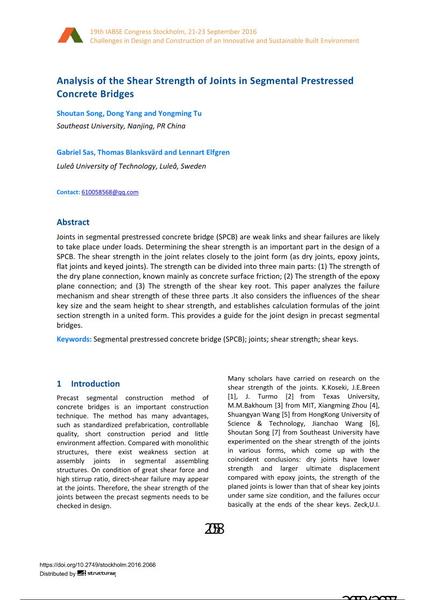Analysis of the Shear Strength of Joints in Segmental Prestressed Concrete Bridges

|
|
|||||||||||
Détails bibliographiques
| Auteur(s): |
Shoutan Song
(Southeast University, Nanjing, PR China)
Dong Yang (Southeast University, Nanjing, PR China) Yongming Tu (Southeast University, Nanjing, PR China) Gabriel Sas (Luleå University of Technology, Luleå, Sweden) Thomas Blanksvärd (Luleå University of Technology, Luleå, Sweden) Lennart Elfgren |
||||
|---|---|---|---|---|---|
| Médium: | papier de conférence | ||||
| Langue(s): | anglais | ||||
| Conférence: | IABSE Congress: Challenges in Design and Construction of an Innovative and Sustainable Built Environment, Stockholm, Sweden, 21-23 September 2016 | ||||
| Publié dans: | IABSE Congress Stockholm, 2016 | ||||
|
|||||
| Page(s): | 2058-2067 | ||||
| Nombre total de pages (du PDF): | 10 | ||||
| Année: | 2016 | ||||
| DOI: | 10.2749/stockholm.2016.2066 | ||||
| Abstrait: |
Joints in segmental prestressed concrete bridge (SPCB) are weak links and shear failures are likely to take place under loads. Determining the shear strength is an important part in the design of a SPCB. The shear strength in the joint relates closely to the joint form (as dry joints, epoxy joints, flat joints and keyed joints). The strength can be divided into three main parts: (1) The strength of the dry plane connection, known mainly as concrete surface friction; (2) The strength of the epoxy plane connection; and (3) The strength of the shear key root. This paper analyzes the failure mechanism and shear strength of these three parts .It also considers the influences of the shear key size and the seam height to shear strength, and establishes calculation formulas of the joint section strength in a united form. This provides a guide for the joint design in precast segmental bridges. |
||||

